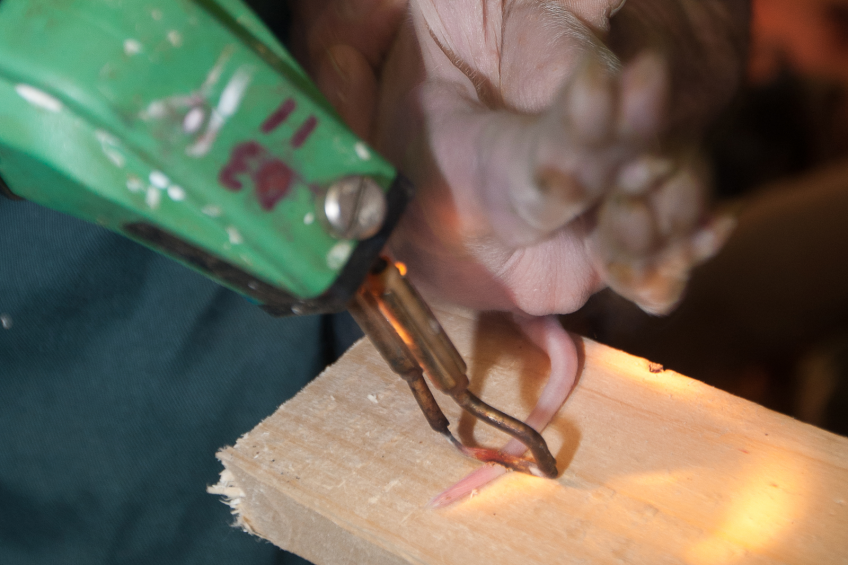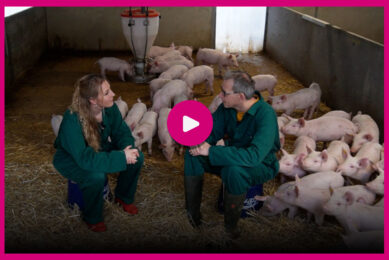What are the effects of tail docking on piglets?

The practice of tail docking is applied to young piglets to avoid a potential later problem of tail biting. But are there effects of docking on piglets? Very few researchers have asked that question, found Dr Pierpaolo Di Giminiani, researcher at Newcastle University, UK.
Is a tail actually a sensitive part of the pig’s body? Dr Pierpaolo Di Giminiani thinks for a while and says, “That is a very good question! I would say it is not more or less sensitive than other parts of the body. The tail is full of neuro-anatomical structures responsible for the pain response. It is comparable to our human skin.” Unlike in many other animals, the pig’s tail may not have a wide range of functions. At best it serves to chase insects away and when in a curl, it gives an indication of the animal’s health. Still, when something happens to that tail, whether this be being docked or bitten, this body part responds like any other.

Biography
Dr Pierpaolo Di Giminiani is a research associate with a focus on ethology (animal behaviour) at Newcastle University, UK. During his graduate studies at Linköping University in Sweden, he studied the cognitive impairment caused by anaesthetic protocols in rodents. At his doctorate at Aarhus University, Denmark, he focused on the assessment of behavioural measures of pain in pigs as a result of cutaneous inflammation. Currently, he investigates pain in pigs in relation to the practice of tail docking in piglets and tail injuries in older pigs.
Tail docking – and especially the effects of tail docking on piglets – has been the focus of Di Giminiani’s studies since the beginning of 2014. They form part of the FareWellDock research programme, an international conglomerate funded by the European Union, zooming in on the common problem of tail biting, the preventive solution of tail docking, virtually common everywhere in Europe, and what can be done to overcome both. Especially tail docking of piglets is a practice which is increasingly frowned upon in some European countries. For more information on FareWellDock, see box below.
Di Giminiani’s studies have mainly centred on the question of whether piglets in the short and long term suffer from any pain from tail docking. In an interview with Pig Progress, Di Giminiani points to pain being a very complex experience and it being difficult to measure properly. He says, “I find it fascinating because there is a lot that we can do, especially in a species like the pig. A lot has been done in humans and laboratory animals and we now have the opportunity to apply novel techniques in other animal species. In addition, pain mitigation is often not provided or done so arbitrarily due to the lack of valid measures of pain in non-verbal animals. Therefore, it still remains one of the big open questions in research.”
Measuring pain in animals
In many other animal studies, Di Giminiani explains, research on pain sensitivity is fairly common. Before he set himself onto the theme of pain in piglets, an academic journey took him from his native Italy to San Diego, United States and later Linköping, Sweden, to learn and discover more on pain perception in laboratory rodents.
In pigs, however, everything was different, he says, as similar research appeared to be virtually absent in pigs when starting his PhD in Denmark at Aarhus University. Indeed, a bit strange, considering that pigs have an important role to play virtually all over the world – and considering the fact that from a medical perspective, pigs and humans are very similar.
The current research on pain sensitivity around tail docking in piglets at Newcastle University roughly revolves around three questions, Di Giminiani explains:
- Is pain actually occurring or not and how long does it last?
- What is the level of pain experience for piglets?
- Based on the outcome, what can be done – for instance the use of painkillers?
Di Giminiani says, “Basically, there are 2 common methods to assess pain in animals:
- To observe spontaneous behaviour. You just observe the activity of the animals, e.g. how much they walk – their locomotion – how much they lie, how much they stand, how do they drink, how do they eat, etcetera.
- “Another method revolves around stimulus and reception – how do animals react to certain controlled challenges? We apply a controlled challenge to evoke a reaction.” This last method had not been applied in pigs a lot, but was used at Newcastle University to figure out short and long-term effects of tail docking on piglets.
Di Giminiani’s research team applied a gas-heated iron for tail docking, so that any wound would immediately be closed to avoid infections. He says, “In addition to measuring responses to controlled stimuli, we developed a grimace scale to measure the facial expressions of piglets. They do seem to grimace, particularly that they squint with their eyes in the minutes immediately following tail docking.” A full scientific paper related to the findings will be sent for publication in the summer of 2016.
Pain in animals in the longer term
The group’s earlier studies, focused on pain sensitivity in the somewhat longer term after tail docking. For this, the piglets and predominantly their docked tails were studied in detail, up to a maximum of 16 weeks after docking. In the microscopic make-up of the tails, changes could be spotted in the weeks after docking, Di Giminiani explains. In a publication in the Journal of Comparative Pathology from July 2016, Di Giminiani and his collaborators concluded that “traumatic neuroma and neuromatous tissue development was not observed one week after tail docking, but was evident one month after tail docking.”
He says, “There is an indication that this is related to pain, as neuromas in humans cause abnormal nerve activity. We suspect that after two months, the sensitivity tends to be normal again.” In other words, it is possible that pain can be felt by piglets between two to four weeks after tail docking. Future research projects will focus on the question whether or not this needs solving by for instance pain relief.
Does it matter?
Another matter is whether or not the industry is actually interested in knowing about the potential outcomes of pain sensitivity of piglets. In the worst case, after all, outcomes might result in a call to change standing practices. Still, Di Giminiani says, “We need to see things in perspective. Tail biting, as reported from abattoirs, may be occurring in 6-10% of undocked pigs, with a maximum of 30% of prevalence of lesions reported. Why do we have to mutilate all piglet tails, only to counteract a possible effect?”
Di Giminiani believes that it should be possible to achieve future management methods in which tail biting is significantly prevented and in which tail docking of piglets is no longer necessary. “There are ways around it, for instance by improving the pig housing and by taking preventative measures like providing rooting material, toys or enrichment, as well as better ventilation. Tail biting can be prevented.”
FareWellDock
FareWellDock is a three-year, EU-funded research project, which aims to increase cooperation and coordination of national research programmes, in order to stimulate the development towards a non-docking policy in the EU. The project is led by Professor Anna Valros at the University of Helsinki, Finland. Apart from Newcastle University, other partners in the project include Scotland’s Rural College (SRUC), INRA (France), Aarhus University (Denmark), Wageningen UR Livestock Research (Netherlands), SLU (Sweden) and the Norwegian School of Veterinary Science.
The research concerns the hazards related to using tail docking as a preventive measure in comparison with the hazard of being tail bitten, as well as on solving some of the main risk factors of tail biting: lack of enrichment, health problems, and delayed detection of an outbreak.











